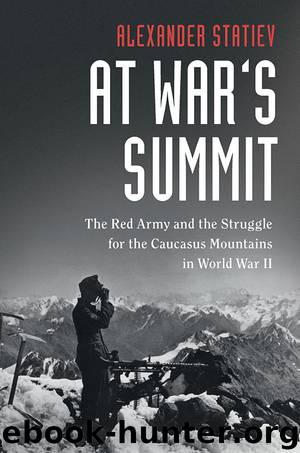At War's Summit: The Red Army and the Struggle for the Caucasus Mountains in World War II (Cambridge Military Histories) by Alexander Statiev

Author:Alexander Statiev [Statiev, Alexander]
Language: eng
Format: epub
Publisher: Cambridge University Press
Published: 2018-06-29T23:00:00+00:00
Figure 7.9 German mountain troops resting in a snow cave.
Credit: BArch, Bild 183-L27357 / Leander Gofferjé
The Plight of the Wounded
Neither the Germans nor the Soviets had thought about the challenges of medical service when they planned action in the high Caucasus. German field hospitals remained stationed to the north of the MCR, and German commanders were, inexplicably, surprised by the difficulty of transporting the wounded across the ridge along steep, narrow mountain trails. At least eight men had to be allotted for carrying each stretcher for long distances, which greatly depleted the force available for combat. Many wounded Germans did not survive the tormenting ordeal.151 The difficulty of evacuation across the MCR was among the key arguments the commanders of the 49th Mountain Corps used when they requested termination of the offensive.
The Soviets were as indifferent as the Germans to this thorny problem, although the experience of the imperial army and Klement’ev’s experiments in the interwar period had shown that there were no easy solutions. The Manual on Mountain Warfare of 1940 stated, ‘In order to avoid frostbite, wounded and sick men should be evacuated as quickly as possible … Stretcher bearers should have sleeping bags, fur socks, gloves, and hats for the wounded.’152 However, not a single order issued on the eve of the battle of the Caucasus by the TCF, the 46th Army, or the 3rd Rifle Corps or any of its divisions addressed medical service in the mountains; explained how to evacuate the wounded; or requested extra stretchers, not to mention equipment presumed by the manual or suggested by Klement’ev.153 Medical service was to be ‘business as usual’, conducted in the same way as on the plains.
Such an attitude ensured that the horrific privations experienced by Soviet soldiers in the high mountains paled in comparison with the sufferings of the wounded. Front-line dressing stations often had no dugouts because it was hard to dig them in the rocky soil; the standard large medical tents could not be pitched above the treeline. Consequently, the wounded lay in the open, with, at best, a cape as a roof. They were able to receive only first aid at the dressing station and had to be taken to field hospitals for surgery.154 Although airplanes evacuated most wounded men, those had first to reach airstrips or field hospitals along mountain trails. Because many of them could not sit on horseback during the ride across the steep slopes, they had to be carried all the way in stretchers. The Marukh field hospital was located 30 to 40 kilometres away from the front-line positions. It generally took three to five days to carry the wounded there from the front-line dressing stations; those wounded in the remotest regions reached field hospitals only after eight or nine days.155 Since evacuation took so long that field medical sections found themselves short of stretchers, many of the wounded had to be carried in capes or blankets for dozens of kilometres, which increased their suffering.156
Heavy rain and snowfall often stalled the transportation of the wounded.
Download
This site does not store any files on its server. We only index and link to content provided by other sites. Please contact the content providers to delete copyright contents if any and email us, we'll remove relevant links or contents immediately.
| Africa | Americas |
| Arctic & Antarctica | Asia |
| Australia & Oceania | Europe |
| Middle East | Russia |
| United States | World |
| Ancient Civilizations | Military |
| Historical Study & Educational Resources |
The Radium Girls by Kate Moore(11624)
100 Deadly Skills by Clint Emerson(4694)
The Templars by Dan Jones(4561)
Rise and Kill First by Ronen Bergman(4547)
The Doomsday Machine by Daniel Ellsberg(4248)
The Rape of Nanking by Iris Chang(4024)
Killing England by Bill O'Reilly(3899)
Hitler in Los Angeles by Steven J. Ross(3801)
Stalin by Stephen Kotkin(3726)
12 Strong by Doug Stanton(3420)
Hitler's Monsters by Eric Kurlander(3165)
Blood and Sand by Alex Von Tunzelmann(3060)
Darkest Hour by Anthony McCarten(3019)
The Code Book by Simon Singh(2860)
The Art of War Visualized by Jessica Hagy(2841)
Hitler's Flying Saucers: A Guide to German Flying Discs of the Second World War by Stevens Henry(2625)
Babylon's Ark by Lawrence Anthony(2433)
The Second World Wars by Victor Davis Hanson(2423)
Tobruk by Peter Fitzsimons(2376)
